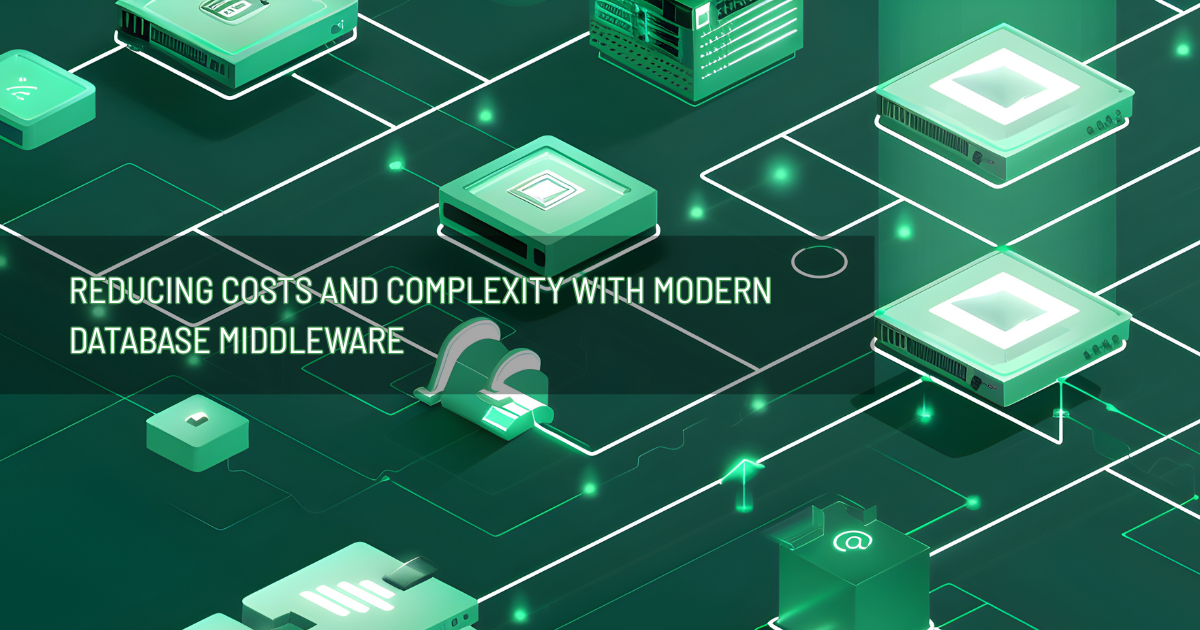Reducing costs and complexity with modern database middleware
Effective data management has become a critical challenge for modern enterprises. Organizations now handle unprecedented data volumes while struggling with the limitations of traditional database systems. Modern database middleware offers a solution by simplifying data access, enhancing performance, and minimizing operational overhead.
This article examines how middleware solutions can lower costs while optimizing data workflows. We’ll explore middleware architecture, its advantages over legacy systems, and practical implementation approaches.
Table of Contents
The growing need for efficient data management
Today’s digital economy depends on effective data handling, yet many organizations struggle with outdated systems. Legacy database infrastructures often require excessive manual intervention, resulting in increased costs and poor performance. Cost-effective database middleware helps automate processes, reduce latency, and improve data flow across systems.
Key challenges with traditional database systems
- High maintenance costs – Scaling outdated systems requires significant resources
- Complex integrations – Connecting different systems creates operational bottlenecks
- Performance issues – Older architectures struggle with modern data workloads
Middleware solutions address these problems by introducing an intelligent layer between applications and databases.
Understanding database middleware
Database middleware serves as a specialized software layer that manages communication between applications and databases. This technology standardizes data interactions while improving overall performance.
Core functions of middleware architecture
- Data abstraction: Provides consistent access to different database systems.
- Query optimization – Processes requests efficiently to reduce database load
- Protocol translation – Enables communication between incompatible systems.
By handling these tasks, middleware solutions significantly reduce the strain on backend infrastructure.
Types of middleware and their benefits
Different middleware types serve specific purposes in enterprise IT environments. Understanding these options helps organizations select the right solution.
- Message-Oriented Middleware (MOM)
- Supports asynchronous communication between systems
- Ideal for distributed application environments
- API-based Middleware
- Uses standardized interfaces for system connectivity
- Enables real-time data synchronization
- Transaction processing middleware
- Ensures reliable transaction execution
- Critical for financial systems and e-commerce platforms
Each type helps simplify complex data environments while improving operational efficiency.
How modern middleware reduces costs
- Automation of processes: Middleware automates repetitive tasks like data integration, API management, and message routing, reducing manual labor and associated costs.
- Improved scalability: Cloud-native middleware solutions allow businesses to scale resources dynamically, paying only for what they use, avoiding over-provisioning.
- Reduced integration costs: Middleware simplifies integration between disparate systems (e.g., legacy and cloud apps), minimizing custom coding and maintenance expenses.
- Enhanced productivity: By providing standardized tools and platforms, middleware reduces development time, enabling faster deployment of applications and services.
- Optimized resource utilization: Middleware improves system performance by load balancing and efficient data handling, reducing hardware and energy costs.
- Lower maintenance overhead: Modern middleware often includes self-healing and monitoring features, reducing downtime and IT support costs.
- Support for microservices: Middleware facilitates microservices architectures, allowing modular updates and reducing the cost of large-scale system overhauls.
- Security and compliance: Built-in security features and compliance tools reduce the need for separate solutions, lowering risk and associated costs.
The evolution of integration technology
Early integration methods relied on fragile point-to-point connections. The evolution of integration technology introduced middleware as a more robust solution.
From batch to real-time processing
- Traditional ETL – Used scheduled batch operations with delays
- Modern middleware – Supports instantaneous data processing.
This advancement helps organizations respond to business needs more quickly.
Implementing middleware solutions
- Assess integration needs: Evaluate existing systems and identify integration requirements to select middleware that aligns with business goals and technical environments.
- Choose scalable platforms: Opt for cloud-native or hybrid middleware solutions to ensure flexibility, scalability, and cost-effective resource management.
- Prioritize interoperability: Ensure the middleware supports seamless connectivity between legacy systems, modern apps, and APIs for efficient data flow.
- Focus on security: Select middleware with robust security features, like encryption and authentication, to protect data and ensure compliance with regulations.
- Plan for monitoring and maintenance: Implement middleware with built-in monitoring tools to track performance, detect issues early, and reduce maintenance efforts.
- Train teams and document processes: Provide training for IT staff and create clear documentation to streamline deployment, management, and future updates.
Modern database middleware has become essential for efficient data management. By implementing the right middleware solutions, organizations can reduce costs while improving operational flexibility.
The evolution of integration technology continues to increase the importance of middleware. Companies that effectively use middleware architecture gain a competitive advantage in today’s data-driven market.
Adopting cost-effective database middleware is no longer optional – it’s a necessity for businesses that want to remain competitive.
Want to simplify your data management?
Struggling with complex databases and high operational costs? Novas Arc specializes in modern database middleware solutions that streamline integrations, reduce expenses, and boost performance. Connect with our experts!
FAQs
- What is database middleware, and how does it reduce costs?
Database middleware is a software layer that connects applications to databases, optimizing queries and automating integrations. It reduces costs by minimizing hardware needs, cutting development time, and lowering maintenance expenses through improved efficiency.
- How can middleware simplify complex data environments?
Middleware standardizes data access across different systems, eliminates manual integrations, and improves performance by optimizing queries. This reduces complexity in hybrid or multi-database setups.
- What are the most cost-effective database middleware solutions available?
Open-source options, such as Apache Kafka for streaming and PostgreSQL with Foreign Data Wrappers (FDWs) for federated queries, offer budget-friendly solutions. Cloud-based middleware (e.g., AWS Glue, Google Dataflow) also provides scalable, pay-as-you-go models.
- Can small businesses benefit from database middleware?
Yes. Middleware helps small businesses automate data workflows, reduce IT overhead, and scale affordably. Lightweight solutions, such as SQLite with middleware extensions or cloud-based tools, make adoption feasible.
- What should I consider before investing in a middleware solution?
- Compatibility with existing databases and apps
- Scalability to handle future growth
- Total cost (licensing, cloud fees, maintenance)
- Performance impact on existing systems
- Vendor support & community adoption
Middleware can transform data management—choosing the right solution depends on specific business needs and technical constraints.
Author








